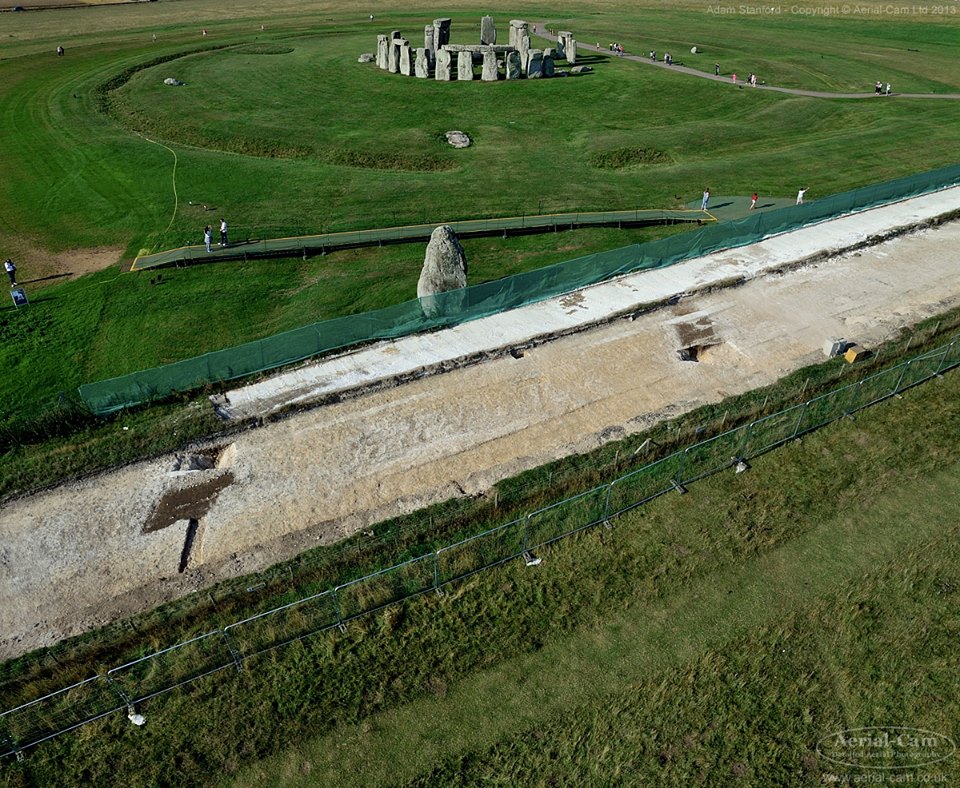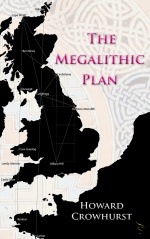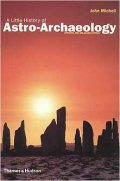<< News >> Summer 2013 discoveries at Stonehenge and 'Interesting' theories
Submitted by Andy B on Tuesday, 10 September 2013 Page Views: 11858
StonehengeCountry: England County: Wiltshire Type: HengeInternal Links:

The two ditches represent either side of The Avenue, a long linear feature to the north-east of Stonehenge linking it with the River Avon. It has long been considered as the formal processional approach to the monument and is aligned with the solstice axis of Stonehenge. But its connection with Stonehenge had been severed by the A344 for centuries as the road cut through the delicate earthwork at an almost perpendicular angle.
The two ditches were found in their expected positions near to the Heel Stone, about 24 metres from the entrance to monument.
Heather Sebire, properties curator and archaeologist at English Heritage, said: "The part of the Avenue that was cut through by the road has obviously been destroyed forever, but we were hopeful that archaeology below the road would survive. And here we have it - the missing piece in the jigsaw. It is very exciting to find a piece of physical evidence that officially makes the connection which we were hoping for."
Dr Nick Snashall, National Trust Archaeologist for the World Heritage Site, said "This is a once in several life time's opportunity to investigate the Avenue beneath the old road surface. It has enabled us to confirm with total certainty for the first time that Stonehenge and its Avenue were once linked and will be so again shortly."
The Avenue is difficult to identify on the ground but is clearly visible on aerial photographs. Once the A344 has been restored to grass in the summer of 2014, interpretation features will be put in place to clearly mark out the solstice alignment to enable visitors to appreciate the position of the Avenue and its intimate connection with and significance to Stonehenge.
Parchmarks at the Stone Circle
The recent prolonged spell of dry weather has also led to some exciting discoveries within the stone circle. Two eagle-eyed members of staff spotted some dry areas of grass, or parchmarks, amongst the stone circle in July. After investigation by English Heritage experts they seem to be positions of three holes where stones 17, 18 and 19 might have stood on the south-west side of the outer sarsen circle.
Susan Greaney, senior properties historian at English Heritage, said: "There is still debate among archaeologists whether Stonehenge was a full or incomplete circle, and the discovery of these holes for missing stones has strengthened the case for it being a full circle, albeit uneven and less perfectly formed in the south-west quadrant."
English Heritage add: NOTE: This story as reported in the Guardian on 9 September contains a number of inaccuracies. The article, including the headline, failed to distinguish between fact and interpretation, and presented one expert’s view as established fact. It also gives the impression that the expert’s view has been adopted by English Heritage. This is very confusing. English Heritage is firmly of the view that Stonehenge was built as a prehistoric temple aligned with the movements of the sun, contrary to what was implied in the article. [MegP Ed NOTE about the NOTE - the Guardian article has now been amended to reflect this, unlike the Daily Mail's parroted version.]
The disembodied voice of English Heritage continues: Professor Mike Parker Pearson’s theory about the naturally formed ridges is interesting, but is by no means established. English Heritage’s role was to record any archaeology that survived under the A344 and present the results of the recent discoveries clearly to the public. English Heritage’s interpretation of Stonehenge in general will be presented at the new visitor centre due to open in December 2013. [Well that's told him! Let us hope 'interesting' is not intended in the apocryphal Chinese manner. I think the adjective to use is fascinating or intriguing (or possibly even Mind-Blowingly, Awesomely Fabulous - see below) - MegP Ed]
More about Stonehenge and many hundreds of photos from the solstices and more generally are on our Stonehenge page and Image Gallery. Read a review of Mike PP's book here.
<< Cavemen were better at drawing animals than modern artists
Linguists identify 15,000-year-old ‘ultraconserved words’ >>






 We would like to know more about this location. Please feel free to add a brief description and any relevant information in your own language.
We would like to know more about this location. Please feel free to add a brief description and any relevant information in your own language. Wir möchten mehr über diese Stätte erfahren. Bitte zögern Sie nicht, eine kurze Beschreibung und relevante Informationen in Deutsch hinzuzufügen.
Wir möchten mehr über diese Stätte erfahren. Bitte zögern Sie nicht, eine kurze Beschreibung und relevante Informationen in Deutsch hinzuzufügen. Nous aimerions en savoir encore un peu sur les lieux. S'il vous plaît n'hesitez pas à ajouter une courte description et tous les renseignements pertinents dans votre propre langue.
Nous aimerions en savoir encore un peu sur les lieux. S'il vous plaît n'hesitez pas à ajouter une courte description et tous les renseignements pertinents dans votre propre langue. Quisieramos informarnos un poco más de las lugares. No dude en añadir una breve descripción y otros datos relevantes en su propio idioma.
Quisieramos informarnos un poco más de las lugares. No dude en añadir una breve descripción y otros datos relevantes en su propio idioma.